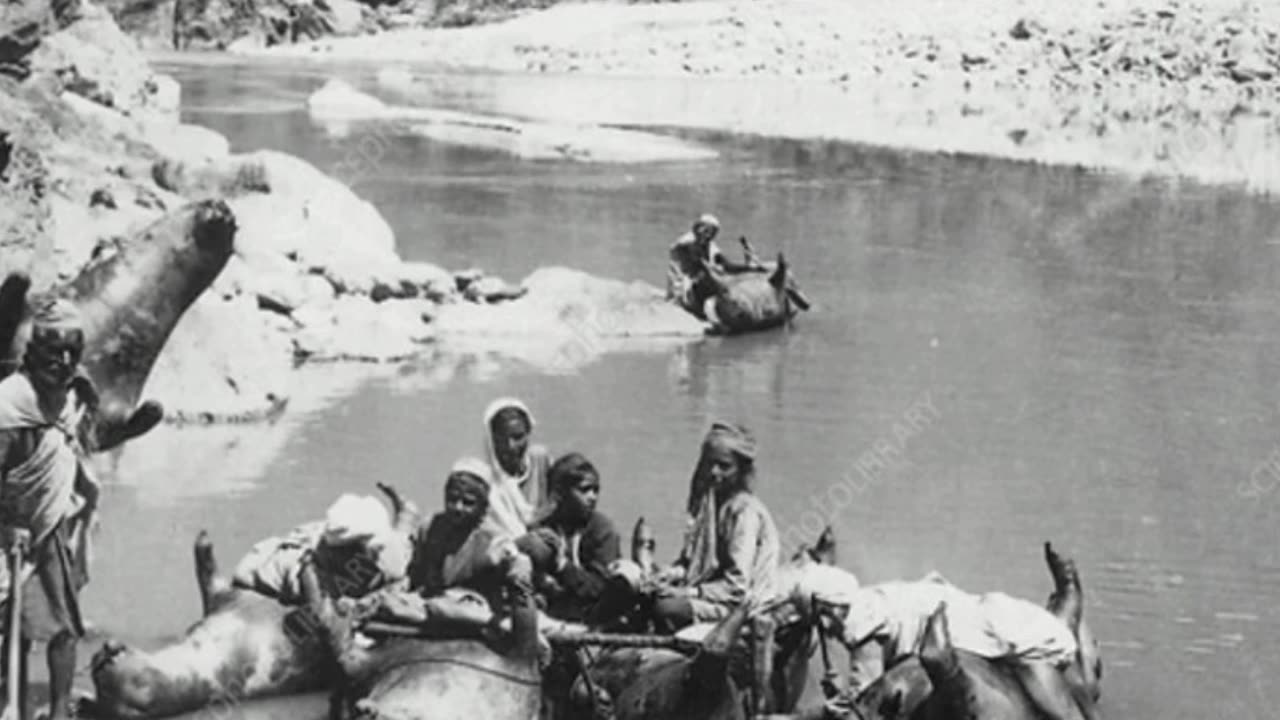Premium Only Content

Inflated Bullock Skins: A Centuries-Old River Navigation Technique
In the early 1900s, during the colonial era in India, inhabitants of the Himalayan and Punjab regions ingeniously employed inflated bullock skins as makeshift boats for ferrying passengers across rivers. This unconventional mode of transportation, which caught the attention of American school teacher, traveler, and photographer James Ricalton, was documented as part of his extensive exploration of the subcontinent's diverse cultures and customs through photography.
While traversing remote villages in the hills of Punjab, Ricalton encountered a scene reminiscent of an ancient practice. The use of inflated skins for river crossings was not exclusive to India, as evidenced by a bas-relief from ancient Mesopotamia at Nimrud. Dating back to the rule of King Ashurnasirpal II (883-859 BC) in Assyria, the relief, now housed in the British Museum, depicts Assyrian soldiers swimming buoyed by small inflated skins, likely sourced from goats.
This age-old technique extended beyond Mesopotamia, finding historical mention in the exploits of notable figures. Cyrus the Great, as chronicled by Xenophon, employed inflated or stuffed animal skins to navigate a Babylonian river. Darius I, in 522 BC, utilized a similar method to cross the Tigris River. The Mongol troops under Genghis Khan carried inflatable animal skins during their westward conquests, and Kublai Khan, his grandson, combined inflated skins with wooden rafts when circumstances demanded.
This ingenious solution persisted through time, with both the Romans and Arabs resorting to the simplicity of inflated skins for river crossings. The story of the bullock skin boats in colonial India thus echoes a broader historical tapestry, connecting a remote Himalayan village to ancient Mesopotamia and the great empires of antiquity.
#ColonialIndia
#HimalayanTransport
#Bullock #Skin #Boats
#JamesRicalton
#punjabvillage
#inflated
#RiverCrossings
#AncientMesopotamia
#AssyrianHeritage
#CyrustheGreat
#genghiskhan
#KublaiKhan
#HistoricalJourney
#GlobalHeritage
#innovation
#techniques
#Lens
#rivernavigation
#CulturalConnection
#history #india
#like #comment
-
 1:41:22
1:41:22
The Officer Tatum
12 hours agoLIVE: Trump NOMINATES Karoline Leavitt, Whoopi "SMOLLETT" EXPOSED, & MORE | Officer Tatum Show EP 8
83.8K213 -
 30:25
30:25
Glenn Greenwald
15 hours agoGlenn Takes Your Questions Post-Election On The Trump Admin & More
180K72 -
 1:26:23
1:26:23
vivafrei
17 hours agoChinese and Indian INFILTRATION in Canadian Government? Live with David Krayden! Viva Frei Live
241K132 -
 52:17
52:17
Candace Show Podcast
17 hours agoFight Night! Me VS Marc Lamont Hill On Transgenderism | Candace Ep 104
226K426 -
 1:12
1:12
Mike Tyson
18 hours ago $33.07 earnedIt's a war.
165K69 -
 1:04:11
1:04:11
In The Litter Box w/ Jewels & Catturd
1 day agoProsecute/Fauci | In the Litter Box w/ Jewels & Catturd – Ep. 692 – 11/15/2024
176K64 -
 5:17
5:17
BFFs: Dave Portnoy, Josh Richards & Bri Chickenfry
10 days agoSmallest Man
303K26 -
 1:45:03
1:45:03
The Quartering
19 hours agoRFK Big Pharma Meltdown, Alex Jones WIN & Shadow Government To Oppose Trump!
180K57 -
 1:53:23
1:53:23
Tucker Carlson
19 hours agoFasting, Prayer, Meditation, & the Global Persecution of Christians (With Hallow CEO Alex Jones)
236K159 -
 53:03
53:03
Ben Shapiro
19 hours agoEp. 2086 - It’s MAHA TIME: Trump Picks RFK Jr.
175K115